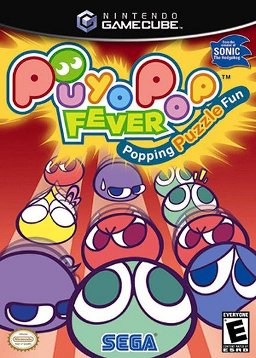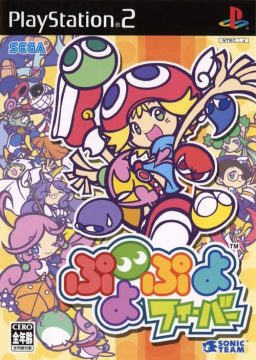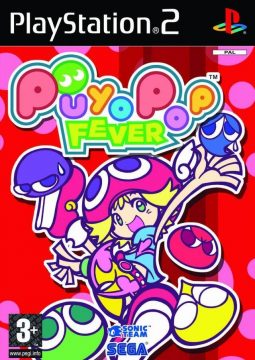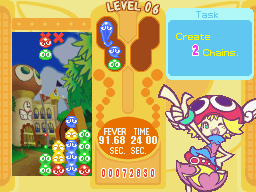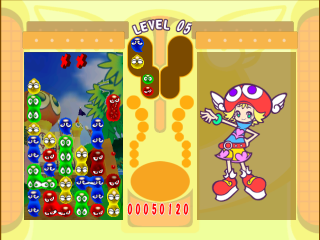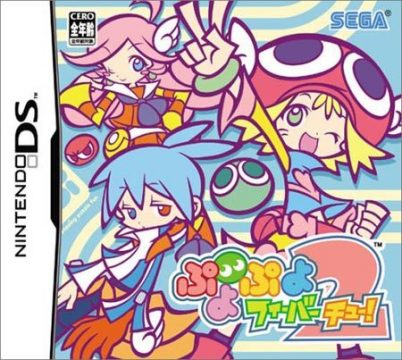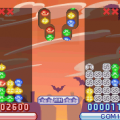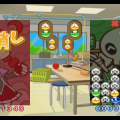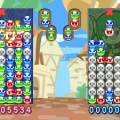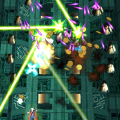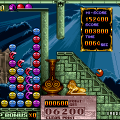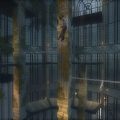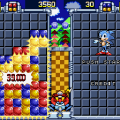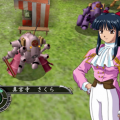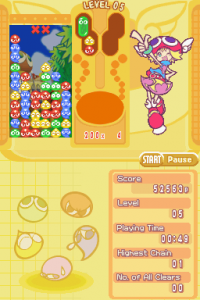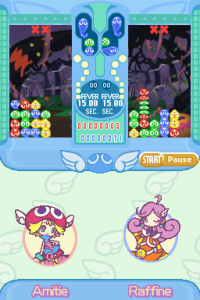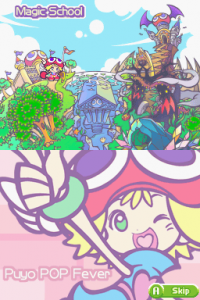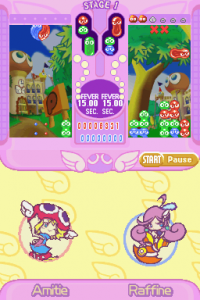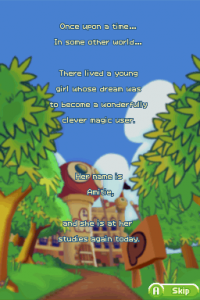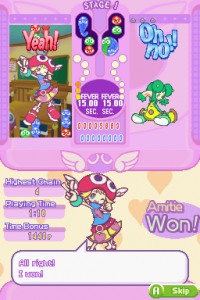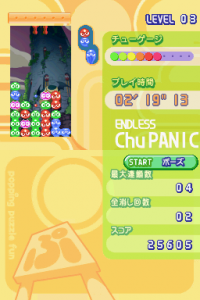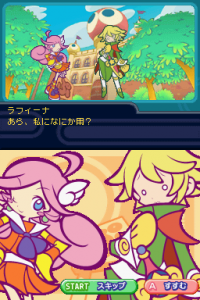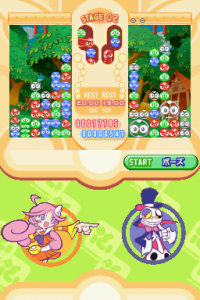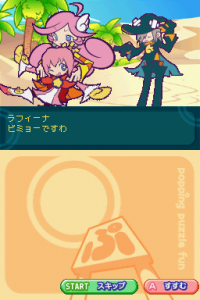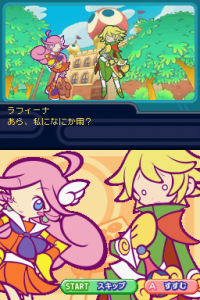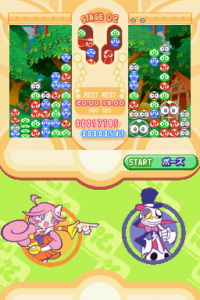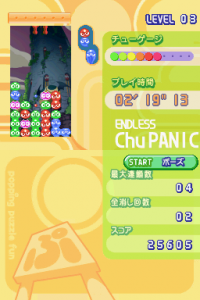After Compile went bankrupt, with Sega in control of the Puyo franchise, they eventually had to make an entry in the main series of games. This was no small task; adding innovation to a game you only handled and made ports of takes quite a bit of careful planning to not mess up. Playing it too safe often led to mediocre results, as Minna de Puyo Puyoshowed. Although it was a large step for Sega, Puyo Puyo Fever (Puyo Pop Fever as its english title), the fifth entry in the main series, actually managed to be a rather fine game. With a new set of characters, gimmicks, and art style, Puyo Puyo Fever started the Sega-era of puyo games with quite the bang.
The main gimmick of this game, like Puyo Puyo SUN, builds off of offsetting. Upon successfully offsetting, you fill one portion of a bar on your side of the screen. Once you fill up the bar (by offsetting seven times), you enter fever mode. In order to allow players to have an easier time entering fever mode, offsetting itself has been changed a little. Previously, if you offset and you didn’t manage to clear every nuisance puyo that was about to drop down, they fall immediately. Now, however, when you offset, you get an extra turn before the nuisance puyo drop down, which means you can keep creating single chains to get into Fever mode.
In Fever mode, two very large changes occur. The first is that your board is replaced with a different board that has a preset chain for you to clear. These preset chains always have an “optimal” place for you to start clearing them. The second is that, if you had any nuisance puyo left over before fever mode, they’re held off until fever mode is finished; this gives you time to clear them using the chains fever mode gives you. Unfortunately, your opponent is still able to send over nuisance puyo to you, and if they do so while you’re in fever mode, nothing can save you besides offsetting. What makes this a bit more problematic (and perhaps evens the playing field in the process) is that, although faster, not only are the strength of fever mode chains a bit weaker than regular chains for most characters, but getting a game over in fever mode means you lose the entire match.
Setting off the chain here correctly results in a five chain. This is an easy mode demonstration–in normal difficulties, there are usually a few puyo about to prevent getting an All Clear easily.
At the start, this preset chain is set so that clearing it unchanged results in a five chain, but there are two outcomes to this situation. The first outcome is that, if you succeed, your board is cleared once more and replaced with another chain, the strength of it one higher than the chain you just cleared. If you fail by clearing any amount of chain less than the ideal number (including a single chain), your board is cleared and replaced with a chain one less than the chain meant to be cleared. Although this may seem simple at first, there’s actually a few complexities that come with it, as there’s a risk/reward strategy involved with this mode. Since success gives you a chain higher than the one you clear, one way to victory is to build off of the chain given to increase the number. However, the price paid for this is time: doing this gives your opponent time to create chains of their own, which allows them to either try to get into fever mode themselves when you launch an offensive, or disrupt the building of your chain. The final strategy involved with fever mode involves time. At the beginning, fever mode only lasts 15 seconds, but you can extend the time it lasts (up to 30 seconds) by having your opponent offset your chains. This presents a good balance between offense and defense and can make players think more strategically about when they wish to attack, though this can serve to stretch out the length of some matches if the offsetting doesn’t stop.
Although fever mode is the main gimmick, that doesn’t mean it’s the only change to the formula. The second large change was the fact that puyo weren’t limited to drop in sets of two like in the previous games. From Puyo Puyo Feveronwards, they could drop in sets of three or even four at times. This was to lend to the final innovation: characters having their own pattern for puyo sets, called dropsets. This correctly did what Puyo Puyo~n attempted to achieve – character differences and allowing people to find playstyles for them – without any of the hassle created by having skills.
Characters
Amitie
The first main heroine. Her self-proclaimed aim is to be a wonderful magic user, though she’s somewhat of a child in that she’s quite carefree, and doesn’t understand much. As if to reflect this fact, her birthday is on Children’s Day. She’s somewhat Arle’s replacement.
Raffine
The second main heroine, and Amitie’s rival. She’s the typical rich-girl stereotype, though what’s special about her is that her magic attacks rely on martial arts, making her somewhat like Rulue.
Accord
The single teacher of Primp Magic School, Primp Town’s (the game’s setting) school. She carries around a cat puppet with her named Popoi, and since it can talk, it’s unknown to many whether or not it has its own will.
Rider
A shy and polite girl, ashamed of her horns and ears. Stutters quite a bit in the first few games due to her shyness.
Oshare Bones
A skeleton obesessed with fashion and looking hip and elegant, taking the topic quite seriously even though he’s dead. The later games reveal he has quite the troubled past due to a lover that went missing.
Dongurigaeru
An acorn frog, since that’s what his name means in japanese. He only says “ribbit”, and is quite hyperactive. Of course, everyone can understand him just fine, and vice versa.
Onion Pixy
A small onion oni. He only says things like “onion” and “boing”, which everyone else can decipher. The later games show him having a girlfriend.
Hohow Bird
A bird that says “Mmhm” a lot. There isn’t much known about it, especially since it doesn’t make many appearances in later games.
Frankensteins
Two Frankenstein’s Monsters. The older one is the father that can’t seem to say much besides “friend”, though the younger one (the son) can fully speak and translates for him.
Tarutaru
Another student at the school. There’s not much special about him other than the fact that he’s somewhat polite, and most likely has a crush on Raffine.
Klug
The typical nerd in class, Klug takes great pride in his vast amounts of knowledge and can come across as stuck-up because of this.
Ocean Prince
The prince of the ocean. Because of his high status, he looks down upon others, as he believes he rules over them. In the next game, he gains a humanoid, feminine form, though it’s not his default form.
Yu
A cheerful ghost. She constantly makes puns and bad jokes no matter the situation. Though it isn’t explained in-game, she’s apparently searching for her brother.
Arle
Though she obviously isn’t a new character, special note should be taken of the fact that she is the only Compile-era character in this game. Unfortunately, she doesn’t play too large of a role in this game. In a nice nod to the Compile era, her dropset is always limited to sets of two puyo. Carbuncle is playable as well as his own character for once, which is odd since he’s almost always seen with Arle.
The story of Puyo Puyo Fever is, like the earlier games, quite simple, leaving the game free to not take itself seriously. Ms. Accord loses her flying cane and tasks each student of her class to locate it for a reward – this includes our two heroines, Amitie and Raffine. The story advances pretty much like the older games, where the heroine wanders around the area and encounters different people, so the general flow of a story is still intact. However, the expressive sprite work of the older games is unfortunately absent; instead, characters have a static full-body “portrait” in cutscenes, and animate based on a direct movement to the portrait, or an outright changing of it. Though it still manages to convey some feeling, it doesn’t do it as well as the older games.
The story mode is split into three courses, which act as difficulties. The first difficulty, RunRun course, features Amitie, with three opponents to face. This is the easy difficulty acts as a tutorial; unrelated to the main story, this simply focuses on Ms. Accord teaching her class on how to play a Puyo match. Although this is supposed to be a tutorial, it isn’t done so well. It gives you basic rules and about one or two strategies, but a new player will be ill-equipped if they ever wish to grasp the concept of building types of chains. However, it’s a step in the right direction due to the lack of adequate tutorials in the earlier games. This mode also points out where you should start to set off a chain if you get into fever mode, which helps out quite a bit for new players. The second difficulty, the WakuWaku course, features Amitie again, this time with eight opponents to face. This is the normal difficulty, and actually tells the main plot, as opposed to the RunRun course. The final difficulty, named the HaraHara course, tells the story from Raffine’s side of the story, and can get rather hard in the later stages – clearing this without a continue (or using a multiple of 7 continues) allows you to face off against Carbuncle, however.
The ports of the game are all similar, and all feature the same endless, mission, and multiplayer modes, though a new addition to the series is that there’s an endless fever mode. In this mode, you’re tasked with getting through as many fever modes as you can before the time runs out, though the time refills slightly after you clear a chain, just like in a regular fever mode. The only time you’ll notice differences is when the DS/GBA ports come into play. Though the other ports have 3D models used for the puyo (and all look the same graphically, a trait that began to carry on in the series), and allow you to save replays, the DS/GBA ports use sprites for said models, and you’re unable to save replays. However, the DS port uses the extra screen for a few things, most notably a four player mode as well as an eight player mode. It also displays the map of the game world during story mode, and uses the touch screen for a few non-mandatory tasks, such as navigating menus. Finally, during battle, there are animations of the players knocking into each other when they activate chains in order to give off the impression of an attack (for a two player battle only). Of course, the DS and GBA ports have a reduced sound quality.
Overall, Puyo Puyo Fever is a good game in Sega’s handling of the series. This game was met rather well, as it somehow managed to shake things up in a way that was somewhat major, but unlike the last two games, didn’t alter the base formula of the series too much to alienate fans. This was a pretty crucial step in Sega’s handling of the franchise, and judging by the fact that the fever mode was in just about every game afterwords, Sega took pride in their hard work. Proving that the series was in good hands, this allowed Sega to create more games, each one better than the one before it.
Screenshot Comparisons
Puyo Puyo Fever 2 (ぷよぷよフィーバーチュー!) – PlayStation 2, PSP, Nintendo DS (2005)
After the great success of Puyo Puyo Fever, Sega decided to take the “if it ain’t broke, don’t fix it” route and played it safe by creating a direct sequel, Puyo Puyo Fever 2. The game manages to maintain the same atmosphere and style as the previous game, but this unfortunately means that there isn’t too much innovation to be had with the game – with the same gimmick from the previous game, it really just feels like Puyo Puyo Fever in more ways than one.
The main innovation revolves around the game’s story mode. Where Puyo Puyo Fever only had three modes of difficulty and two main characters to play as, in this game, you have a choice of three characters to play as, each with three sets of difficulties and stories to boot. This lets you get more of a feel for the characters and the universe, since such things weren’t defined so well in the last game. A second, smaller innovation ties into story mode as well; throughout the game, you gain items that you can use in said mode. The effects of these items range in severity, like starting you off with a small, preset chain at the beginning of a battle, or playing as a different character (and thus using their dropset). You can buy these items from an in-game shop as well, since you now get points depending on your performance after a puyo match, a small reward that’s kept in all future games.
New characters
Sig
The third main character, alongside Amitie and Raffine. He’s a boy who comes from parts of a demon, which explains his heterochroma and red claw. He’s rather laid back, and doesn’t show much emotions in his lines.
Lemres
A warlock who really loves sweets, so much so that he freely offers it to anyone he meets. Though he carries a broom at first, in later games he holds a wand.
Feli
A gothic girl that seems to practice in dark magic, as she’s usually engaged in some sort of uninteligable ritual. She makes it quite obvious that she has a crush on Lemres.
Baldanders
A dog wearing knight’s armor. He’s Feli’s pet, as she accidentally summoned him. He only ever “speaks” in dog noises.
Akuma
A demon bear doll. He likes to end his sentences with “kuma” (bear), and often quickly swaps between talking normally and shouting his lines.
Gogotte
An elf that makes soup with mushrooms, and wishes for others to eat said soup. He doesn’t make any appearances in the main games after this game, however.
Because of these innovations, it’s clear Sega wanted story mode to be the main focus of the game, though this unfortunately comes at a cost to the other sections of the game. Once more, there are the traditional endless, mission, and endless fever modes, though there are two slight additions. The first addition is a mode called endless chu panic. This mode is basically endless mode, but with a slight twist; after every turn, a bar begins to fill up. Once that bar fills up, a few nuisance puyo begin to queue up, and you have another turn to either offset them or do nothing before they fall down. Though these are a different color and appearance than regular nuisance puyo, they act the same; the only difference is that these are pink and say “chu” when they drop down. This mode sort of speeds up a typical endless mode since there’s more of a danger to be had, but it doesn’t add a substantial change to the formula. Because of this, the mode wasn’t brought over to any future games. The second addition is a mode where you’re tasked with fighting a series of characters, one after the other. You’re only given a limited amount of continues, and the mode is basically about seeing how far you can get before losing, as not only does the AI get harder and harder with each successive victory, but so does the drop speed and number of colored puyo. This mode was a bit more well-received, since it offered a different sort of challenge, and was kept in future games in some shape.
Unfortunately, there isn’t much of an improvement with the graphics; the PS2/PSP version of the game pretty much copies the graphics from the earlier console ports. The most improvement you’ll see is with the DS version: many of the spell animations have been reworked, and the spritework seems to be redone as well. With that and the obvious music quality change, the final difference between ports is that the DS version still has an 8 player mode, so it’s mostly up to preference which port you prefer as far as actual gameplay goes.
Puyo Puyo Fever 2 is an acceptable sequel, but due to it not adding too much to shake things up, it isn’t exactly an essential game in the series that you need to play. However, it’s still a solid game in itself, and it’s at least worth a glance if you’re looking for a way to waste time.

